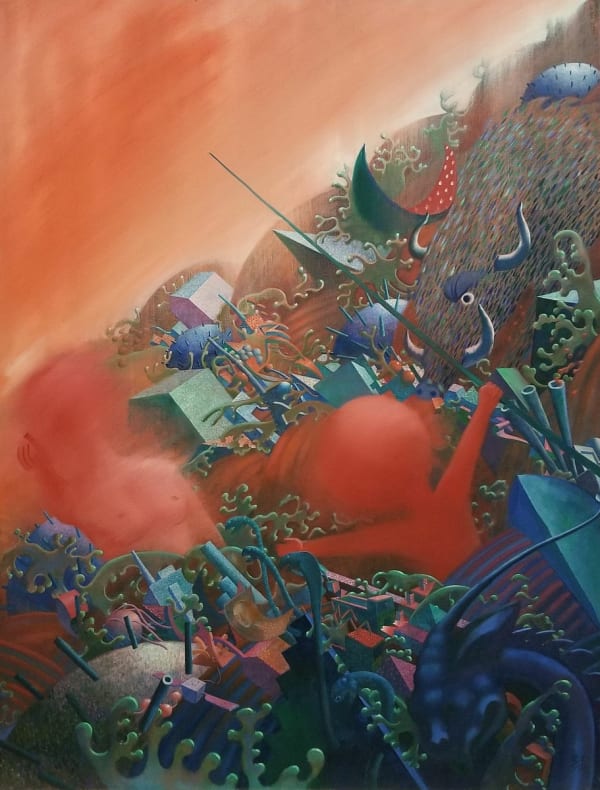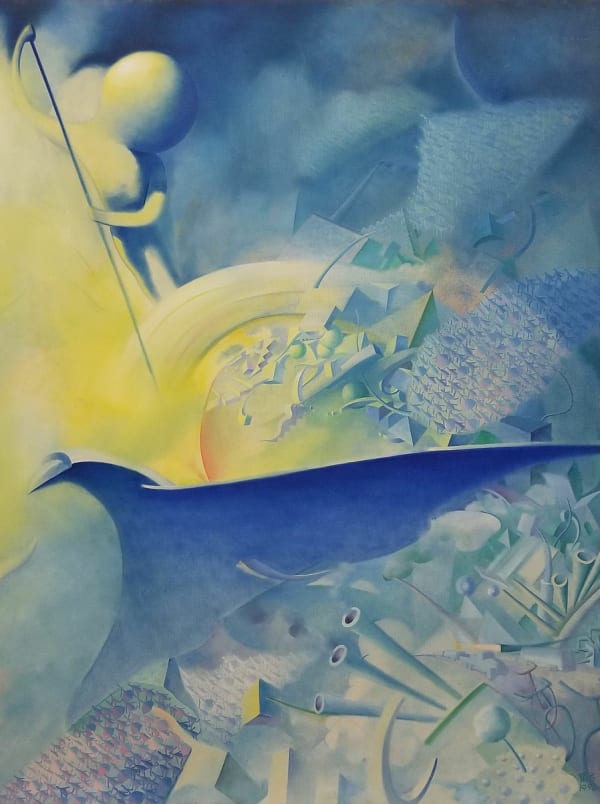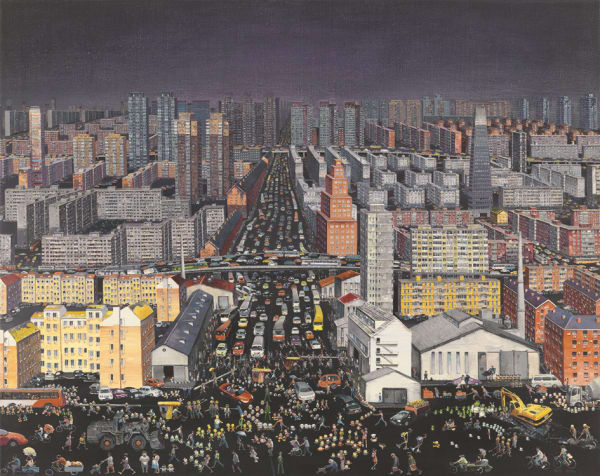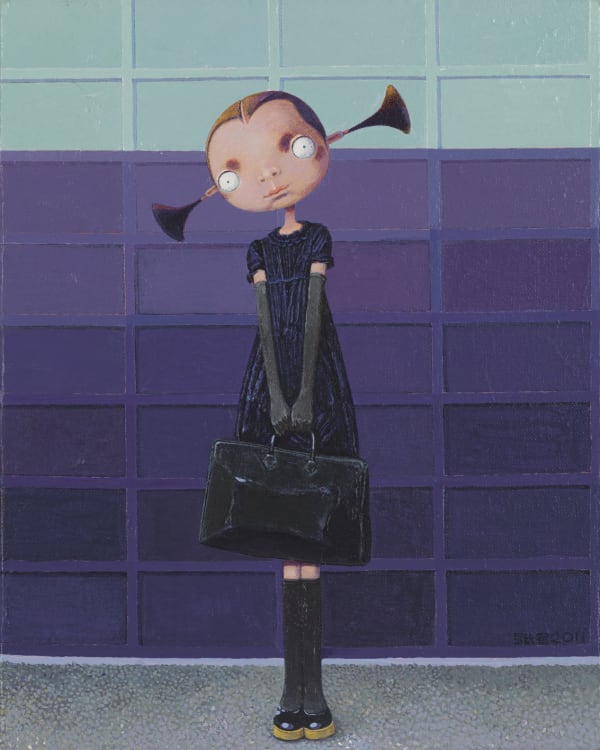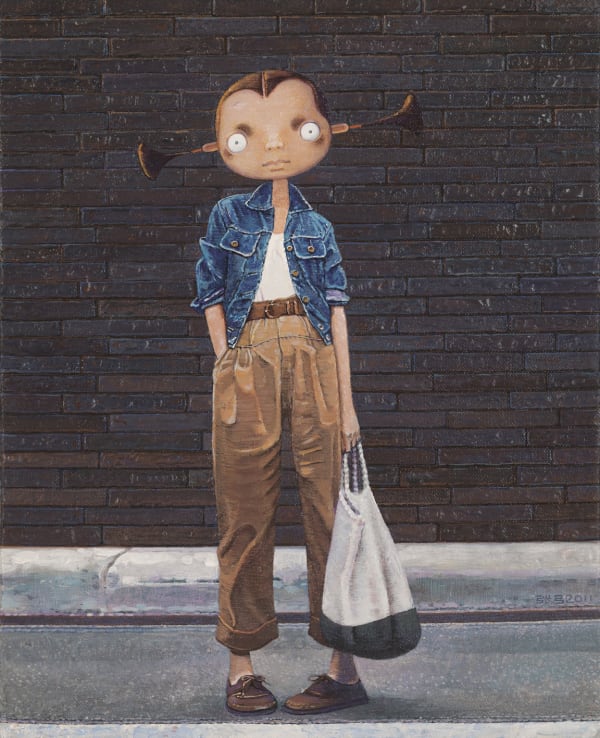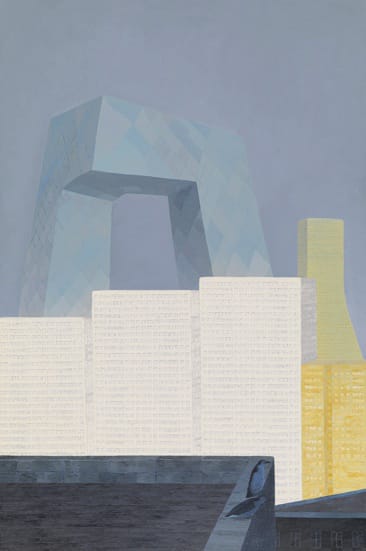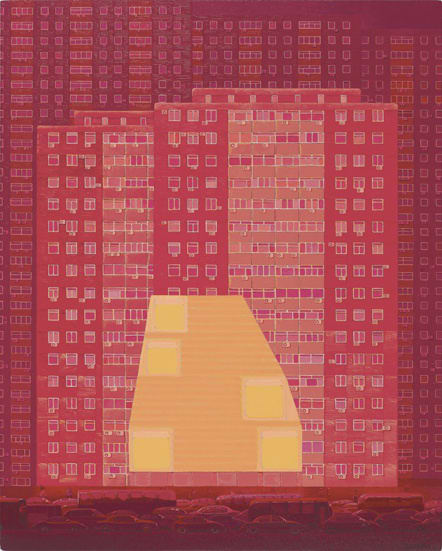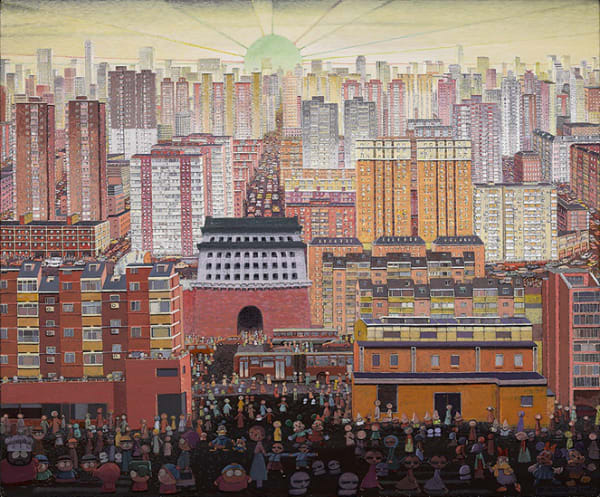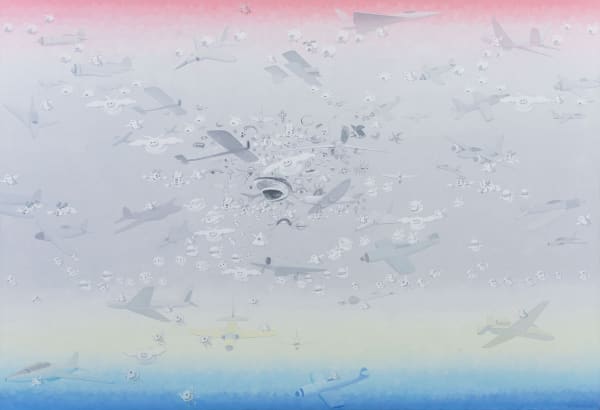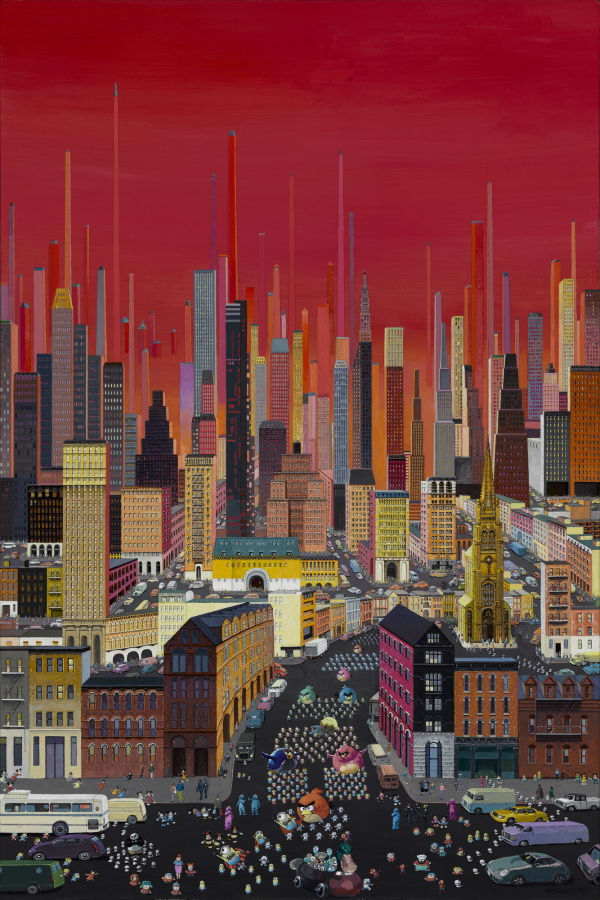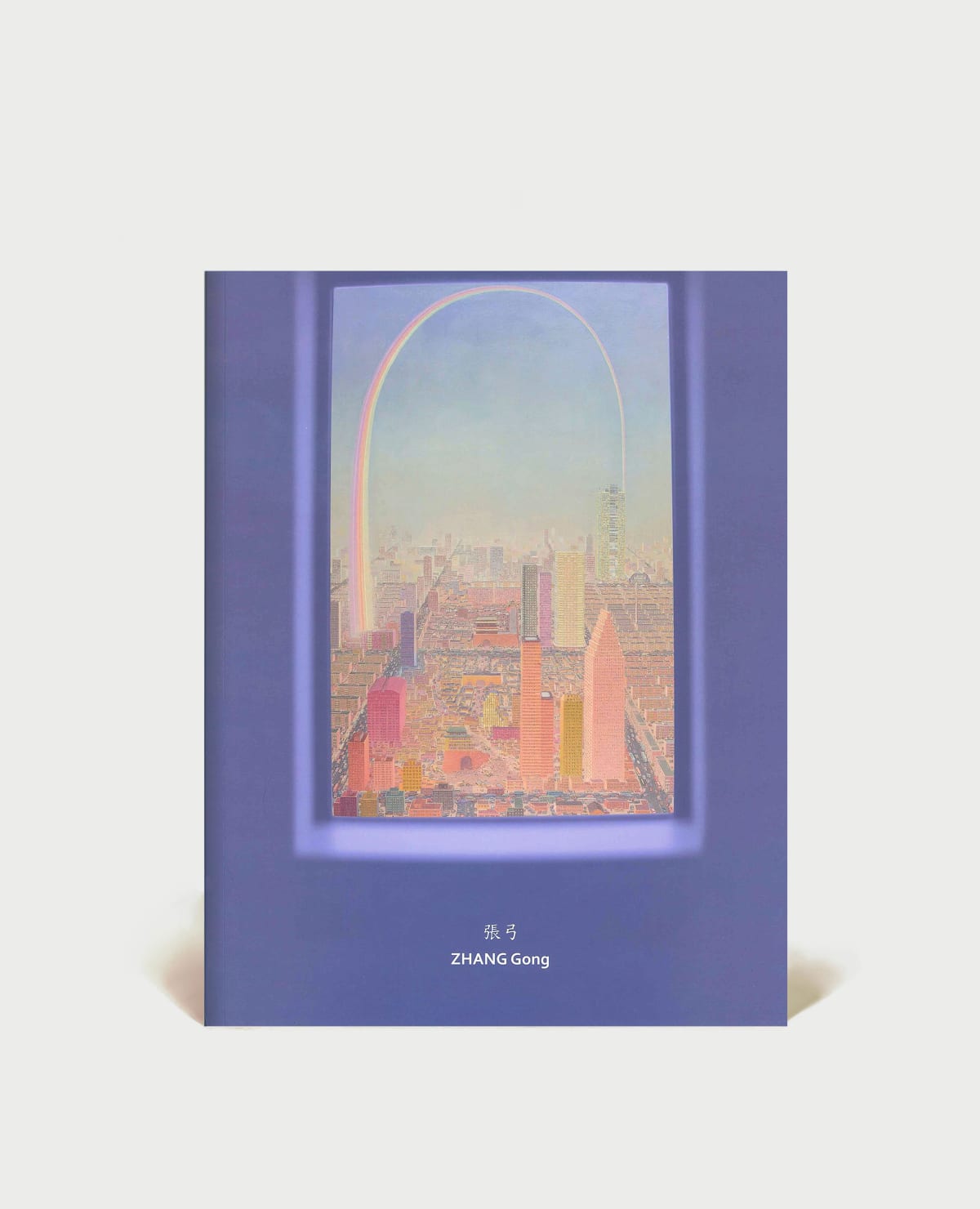Zhang Gong 張 弓 b. 1959
-
 Elements of Love 《情人要素》, 1993
Elements of Love 《情人要素》, 1993 -
 No Direction 《失去了前進方向》, 1994
No Direction 《失去了前進方向》, 1994 -
 Light of God 《英神之光》, 1996
Light of God 《英神之光》, 1996 -
 Attacking Big Bird 《鷹擊長空》, 1996
Attacking Big Bird 《鷹擊長空》, 1996 -
 Beijing No.2 《北京城二號》, 2010
Beijing No.2 《北京城二號》, 2010 -
 Beijing No.1 《北京城一號》, 2010
Beijing No.1 《北京城一號》, 2010 -
 The Family of Miss Panda 《潘大姐一家》, 2011
The Family of Miss Panda 《潘大姐一家》, 2011 -
 Miss Panda 《潘大小姐》, 2011
Miss Panda 《潘大小姐》, 2011 -
 Miss Panda on Street 《街頭的潘大姐》, 2011
Miss Panda on Street 《街頭的潘大姐》, 2011 -
 The Family of Xiao Tang 《小唐一家》, 2011
The Family of Xiao Tang 《小唐一家》, 2011 -
 Beijing Grows Cuke 《北京長出了小黃瓜》, 2012
Beijing Grows Cuke 《北京長出了小黃瓜》, 2012 -
 Meeting at Café No.3 《相約咖啡館 3》, 2012
Meeting at Café No.3 《相約咖啡館 3》, 2012 -
 The Rem Koolhaas on the Third Ring Road 《三環路的庫哈斯》, 2012
The Rem Koolhaas on the Third Ring Road 《三環路的庫哈斯》, 2012 -
 Blues Disco No. 2 《藍調迪廳 2》, 2012
Blues Disco No. 2 《藍調迪廳 2》, 2012 -
 Imitation of Frank Gehry in Beijing 《弗蘭克·蓋瑞,北京山寨》, 2012
Imitation of Frank Gehry in Beijing 《弗蘭克·蓋瑞,北京山寨》, 2012 -
 Ms Red on Sofa 《沙發上的紅姐》, 2012
Ms Red on Sofa 《沙發上的紅姐》, 2012 -
 Meeting at Café No.3 《相約咖啡館 3》, 2012
Meeting at Café No.3 《相約咖啡館 3》, 2012 -
 Mickey Mouse and Donald Duck at War 《米老鼠大戰唐老鴨 》, 2013
Mickey Mouse and Donald Duck at War 《米老鼠大戰唐老鴨 》, 2013 -
 Café in Yellow and Red 《咖啡館黃紅》, 2013
Café in Yellow and Red 《咖啡館黃紅》, 2013 -
 Café in Grey and Blue 《咖啡館灰藍》, 2013
Café in Grey and Blue 《咖啡館灰藍》, 2013 -
 Beijing No.5 《北京城五號》, 2014
Beijing No.5 《北京城五號》, 2014 -
 Beijing No.3 《北京城三號》, 2014
Beijing No.3 《北京城三號》, 2014 -
 Beijing No.4 《北京城四號》, 2014
Beijing No.4 《北京城四號》, 2014 -
 Front Gate Tower of Beijing City 《北京城前門樓》, 2015
Front Gate Tower of Beijing City 《北京城前門樓》, 2015 -
 Metropolis No.2 《大都會二號》, 2015
Metropolis No.2 《大都會二號》, 2015 -
 Metropolis No.1 《大都會一號》, 2015
Metropolis No.1 《大都會一號》, 2015 -
 Night is Gone 2 《夜遠去 2》, 2015
Night is Gone 2 《夜遠去 2》, 2015 -
 Metropolis No.4 《大都會四號》, 2015
Metropolis No.4 《大都會四號》, 2015 -
 Hallelujah (Series Five) 《哈利路亞系列五》, 2015
Hallelujah (Series Five) 《哈利路亞系列五》, 2015 -
 Hallelujah (Series Five) 《哈利路亞系列五》, 2015
Hallelujah (Series Five) 《哈利路亞系列五》, 2015 -
 Kids, Don't be Afraid 4《小孩不怕 4》, 2016
Kids, Don't be Afraid 4《小孩不怕 4》, 2016 -
 Speechless Dinosaur 《不會說話的恐龍》, 2016
Speechless Dinosaur 《不會說話的恐龍》, 2016 -
 Metropolis No.6 《大都會六號》, 2016
Metropolis No.6 《大都會六號》, 2016 -
 Metropolis No.5 《大都會五號》, 2016
Metropolis No.5 《大都會五號》, 2016 -
 Good Promise 《美好承諾》, 2017
Good Promise 《美好承諾》, 2017 -
 Why Can't a Panda Become an Elephant? 《熊貓為什麼不能變成大象?》, 2017
Why Can't a Panda Become an Elephant? 《熊貓為什麼不能變成大象?》, 2017 -
 Mr. Godot Will Definitely Come Tomorrow 《戈多先生明天一定來》, 2017
Mr. Godot Will Definitely Come Tomorrow 《戈多先生明天一定來》, 2017 -
 Wandering 2 《遊蕩 2》, 2017
Wandering 2 《遊蕩 2》, 2017 -
 Meditating Dharma 《修佛》, 2017
Meditating Dharma 《修佛》, 2017 -
 Sentimental Garden 《感傷的花園》, 2018
Sentimental Garden 《感傷的花園》, 2018 -
 Treasure of August 《八月的寶貝》, 2018
Treasure of August 《八月的寶貝》, 2018
1992 - 1999: Surrealist paintings
Western contemporary art and various progressive theories and ideas flooded into china in the 1990s. These conditions influenced zhang gong, who became eager to engage in dialogue with his audiences and society at large through the medium of painting. Much of this intent is concealed in the absurd yet humorous symbols of his early surrealist paintings. The cartoon-like subjects of these paintings not only convey the subtleties of the artist's inner monologues, but also express concern for the rapid transformation of chinese society, and even offer various reflections on cultural, environmental and living conditions. Bright colour tones and well-structured layouts became his signature style.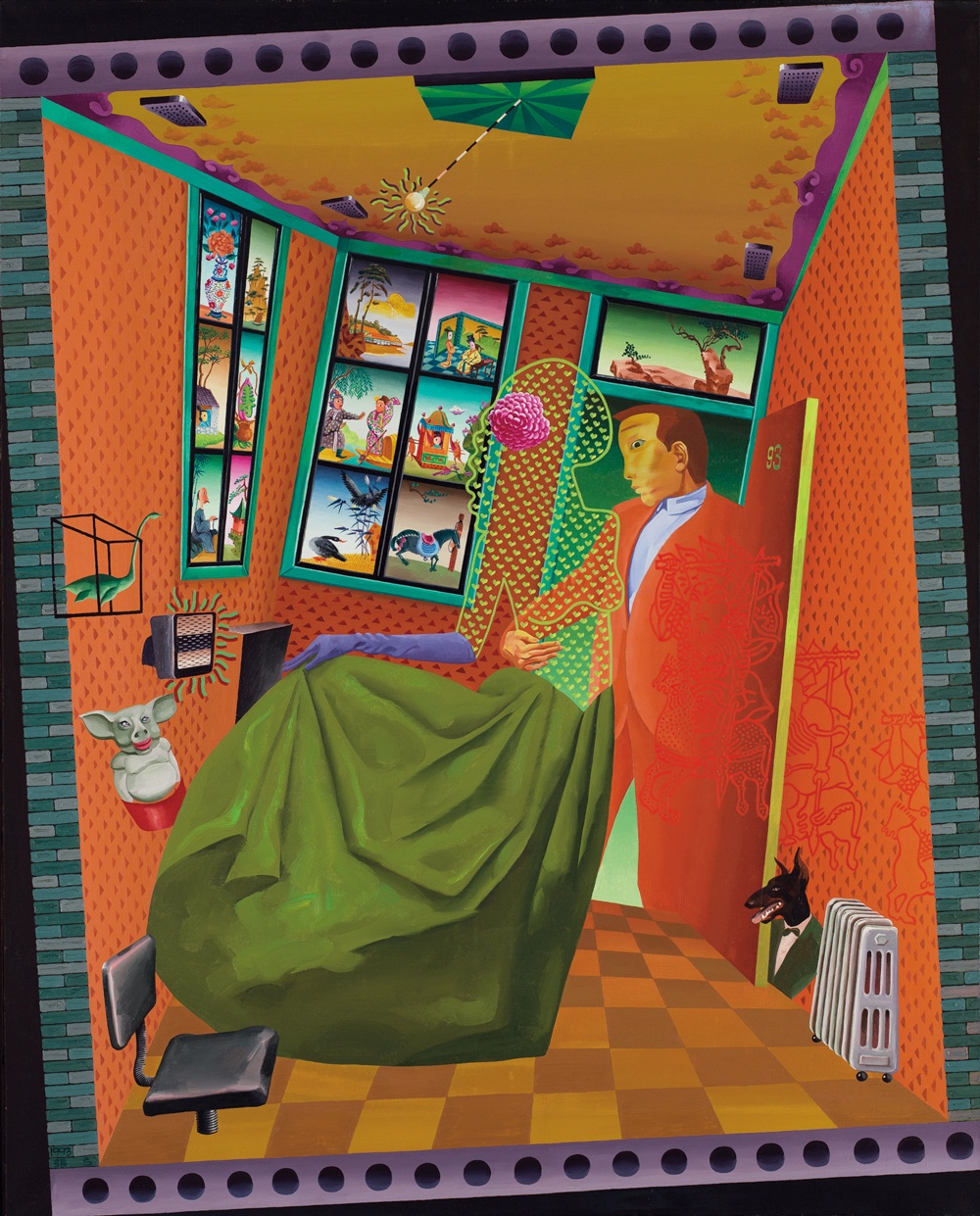
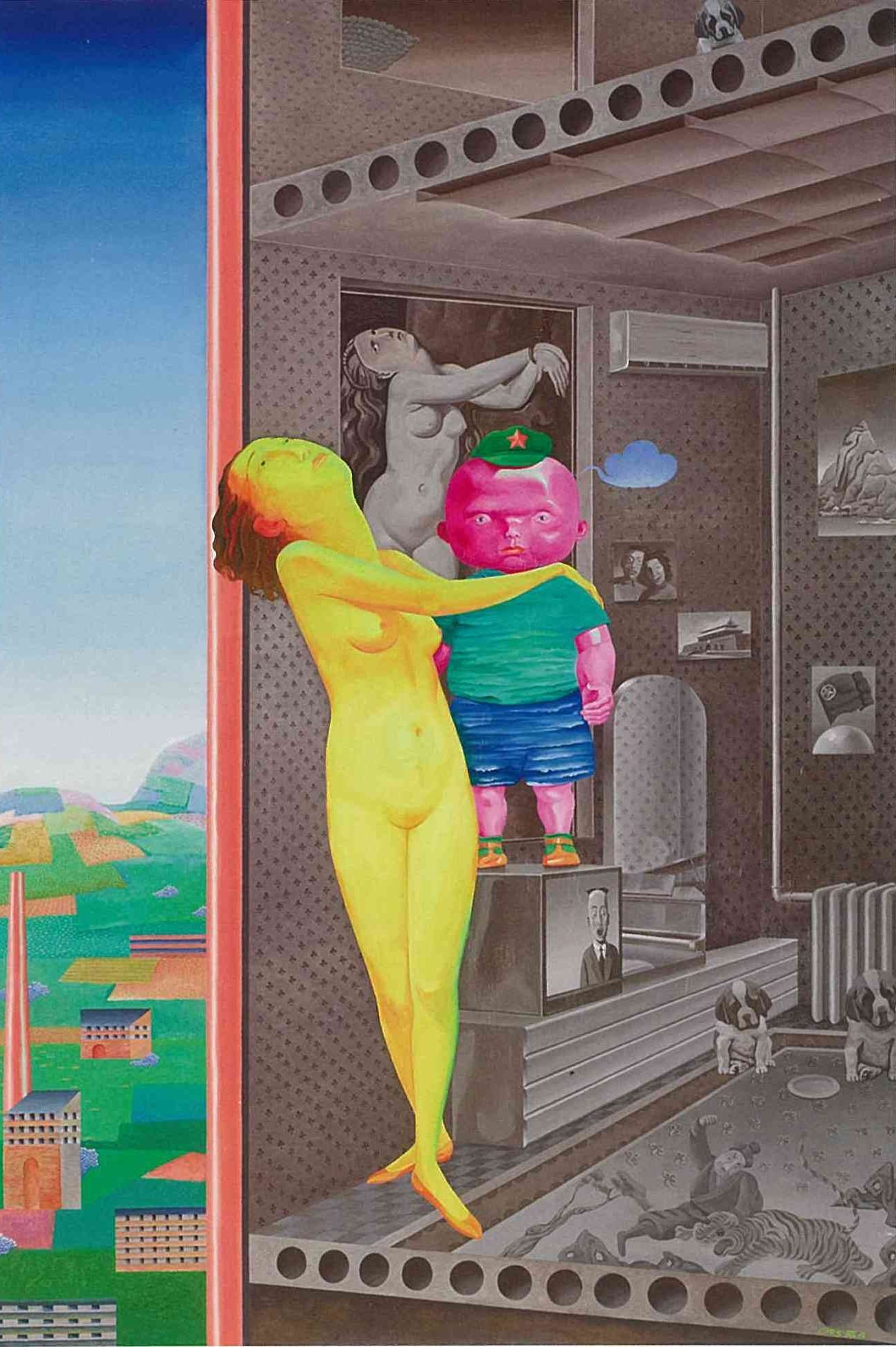

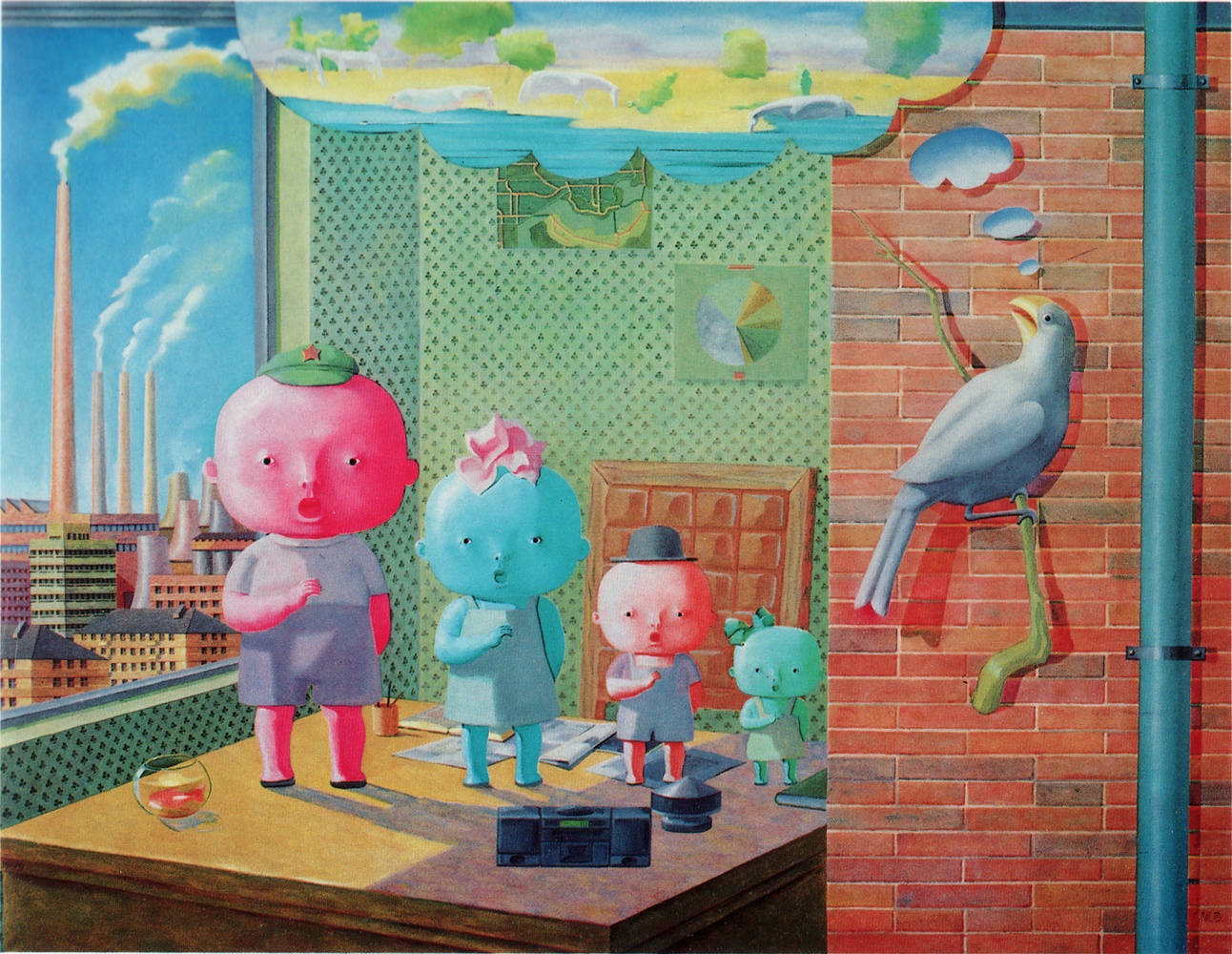
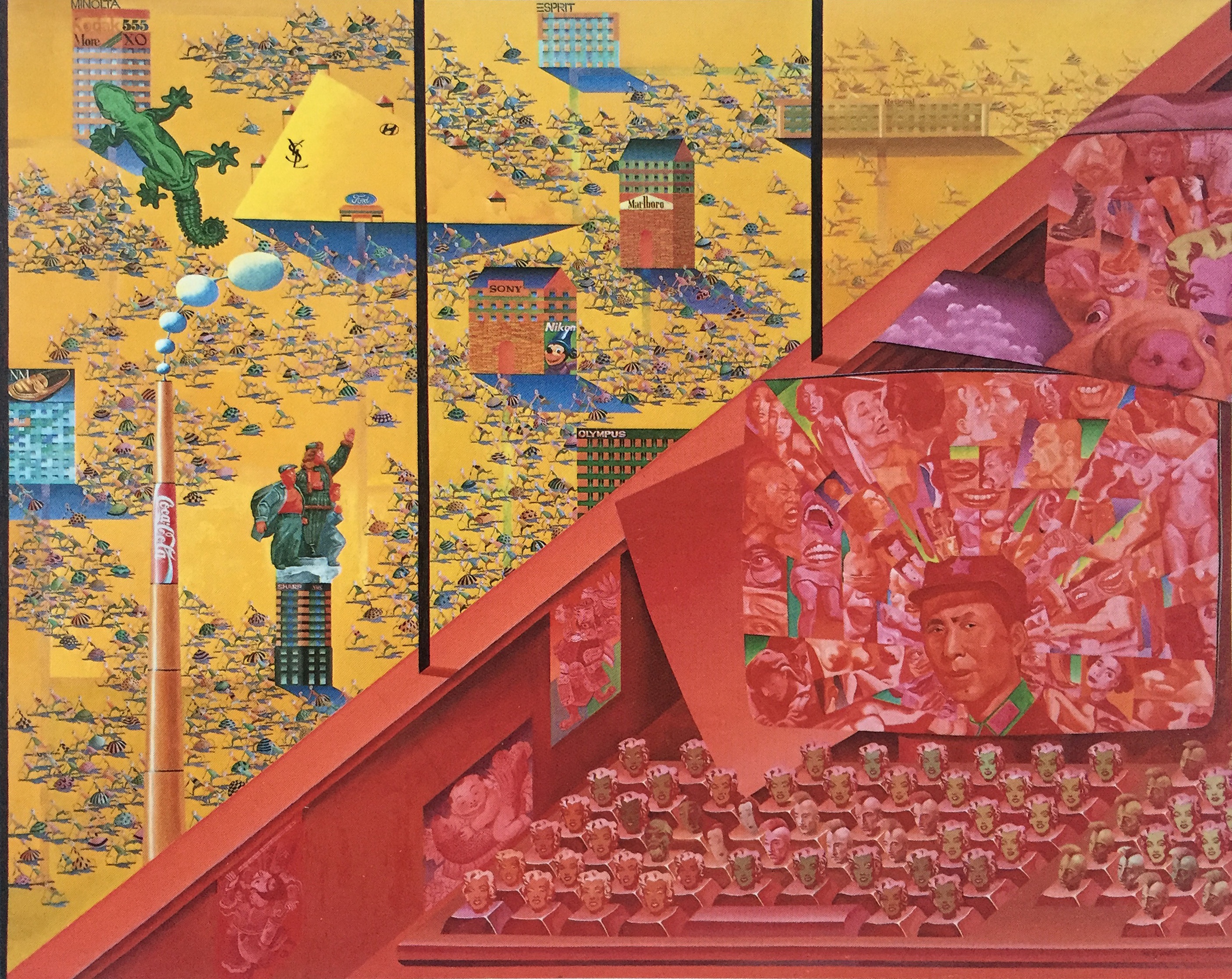
1999 - 2009: Diving into the world of animation
Zhang gong began to create animated short films in 1999, as part of his enquiry into different expressions of complex artistic concepts and how to convey these messages to a larger audience. Over the course of a decade, he created several hand-painted short films, including Trees (2003), Birds (2004), Black Pig, White Pig (2005), The Perturbation of the Mind (2006) and Miss Red (2009). Relying on his innermost emotions to deliver authentic stories of these whimsical characters, whilst reflecting upon the injustices arising from the rapid development of chinese society, zhang gong steers the viewer towards self-examination and reflection upon human values.
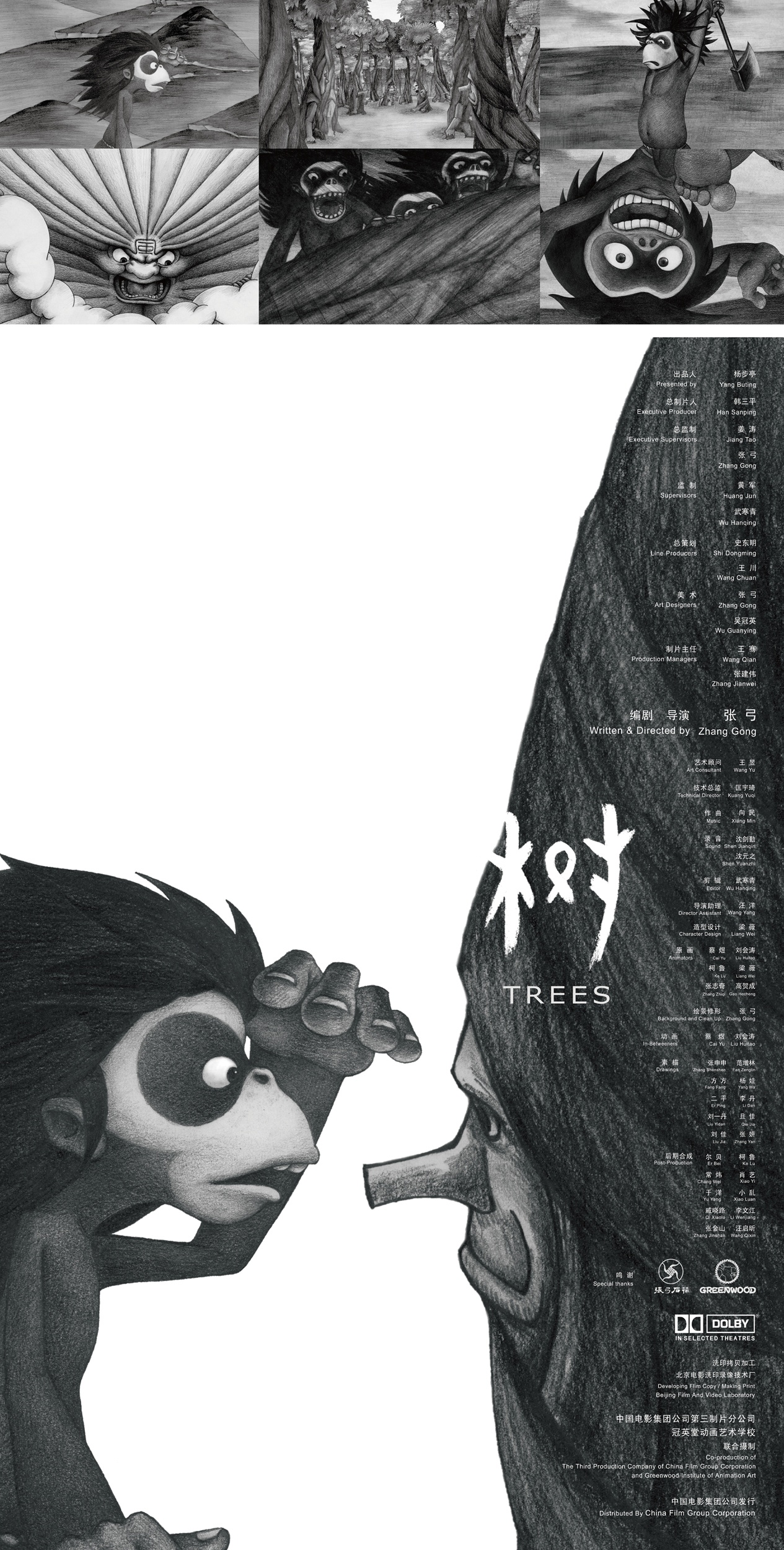
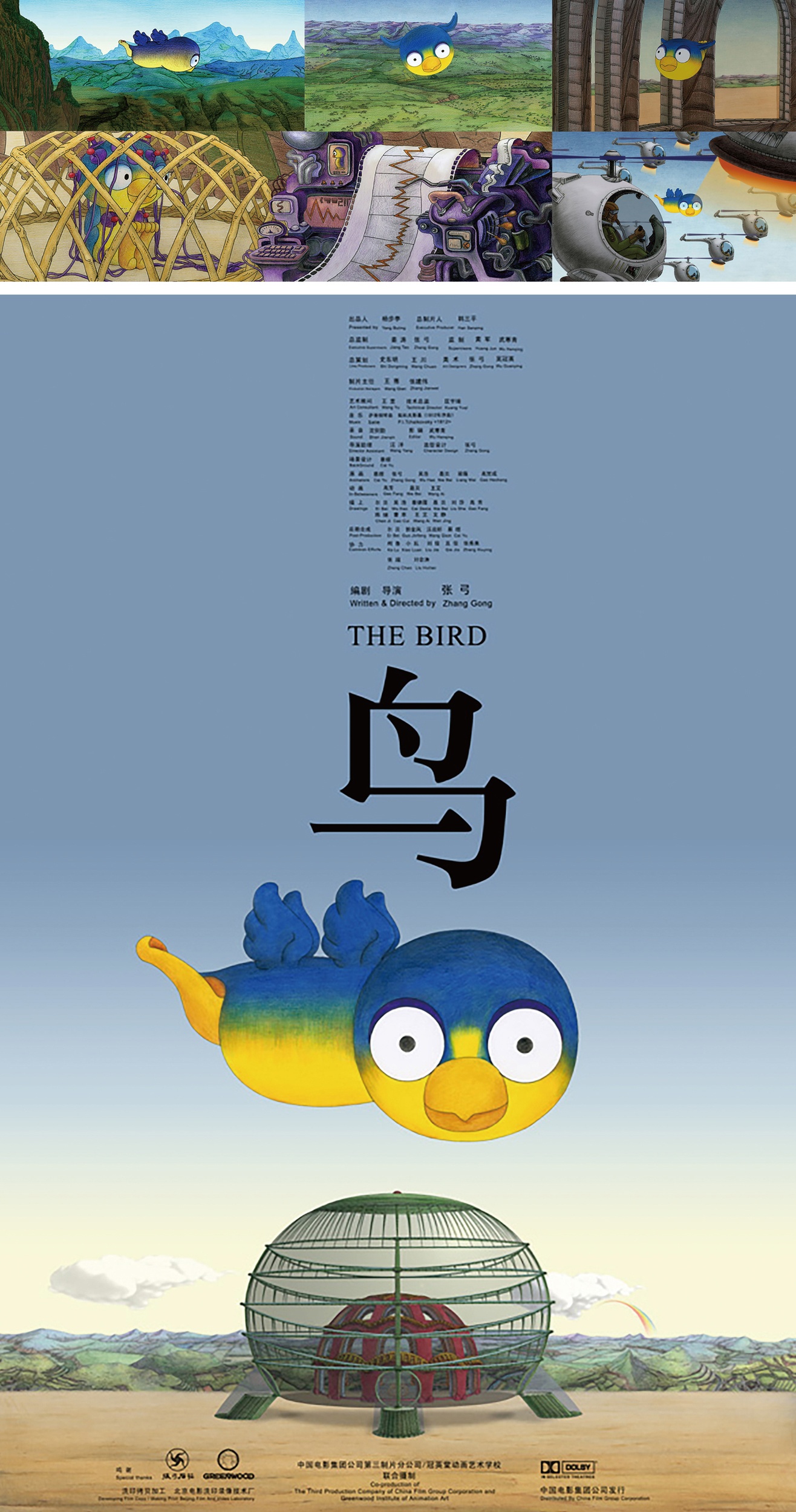
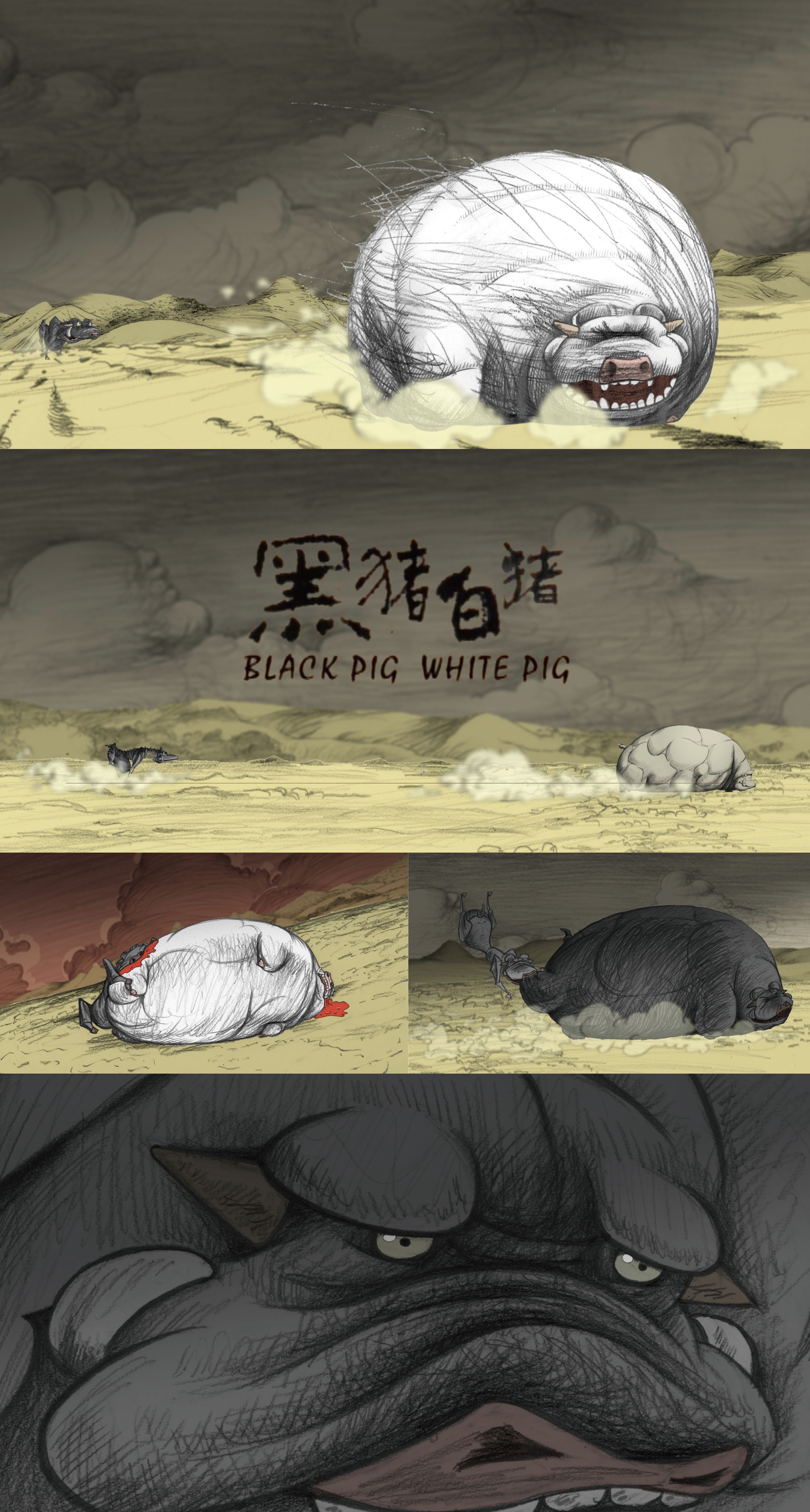
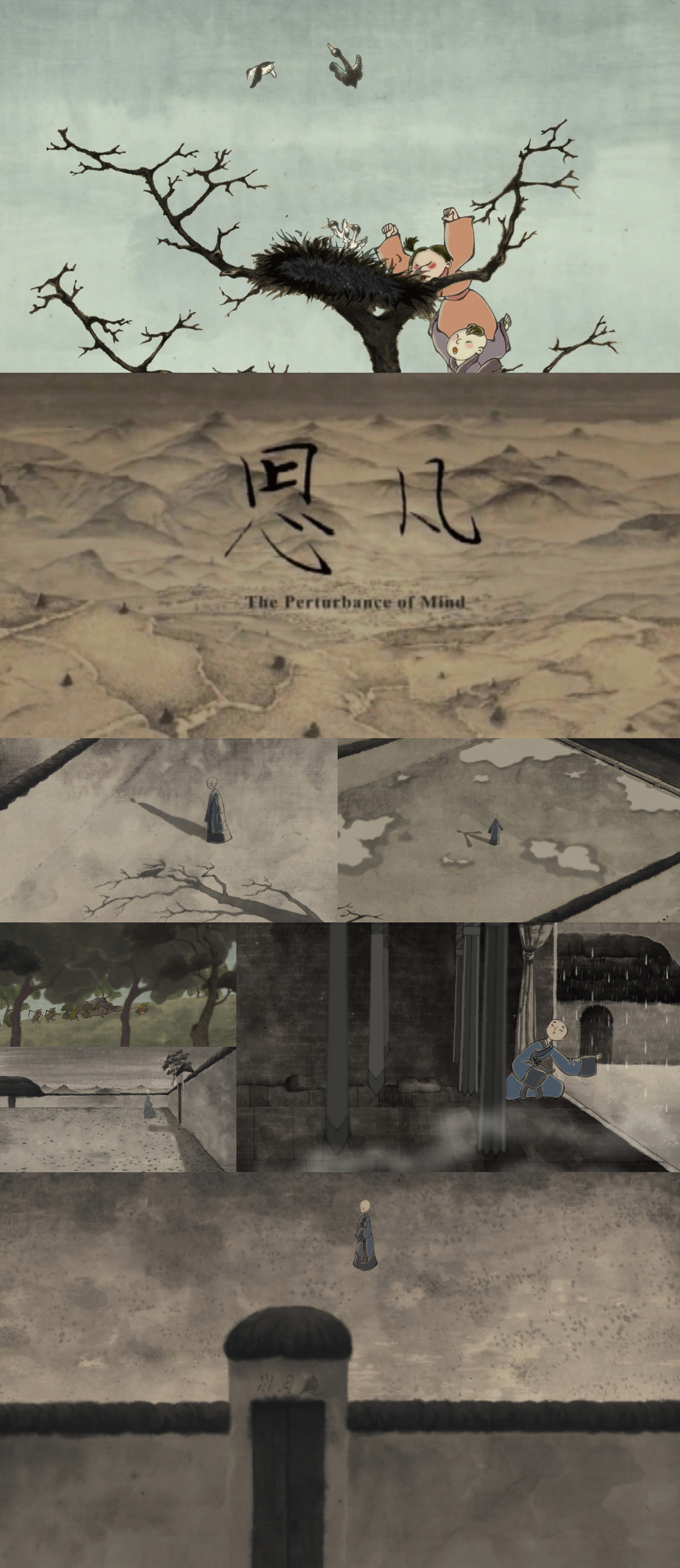
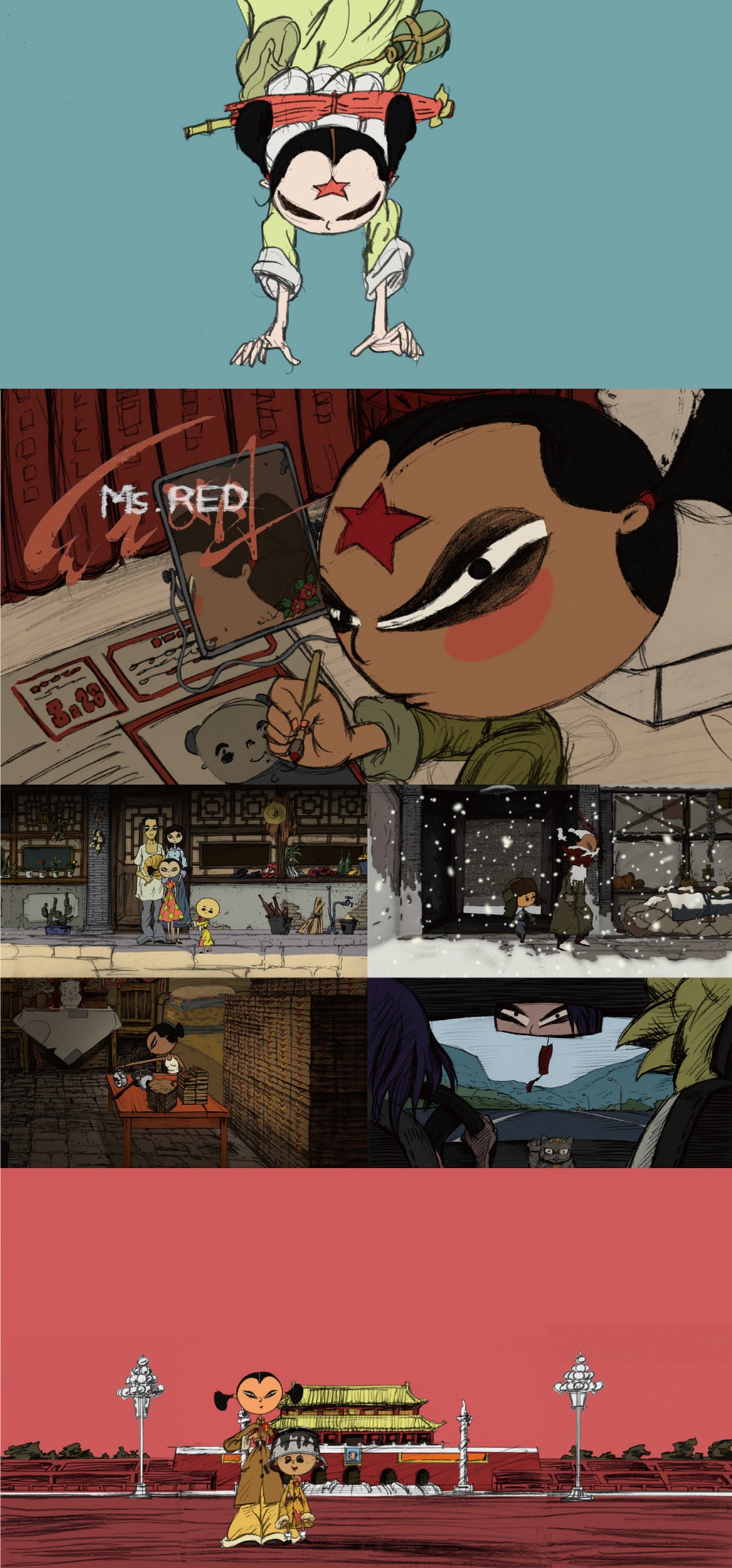
2007: Repositioning cartoon characters
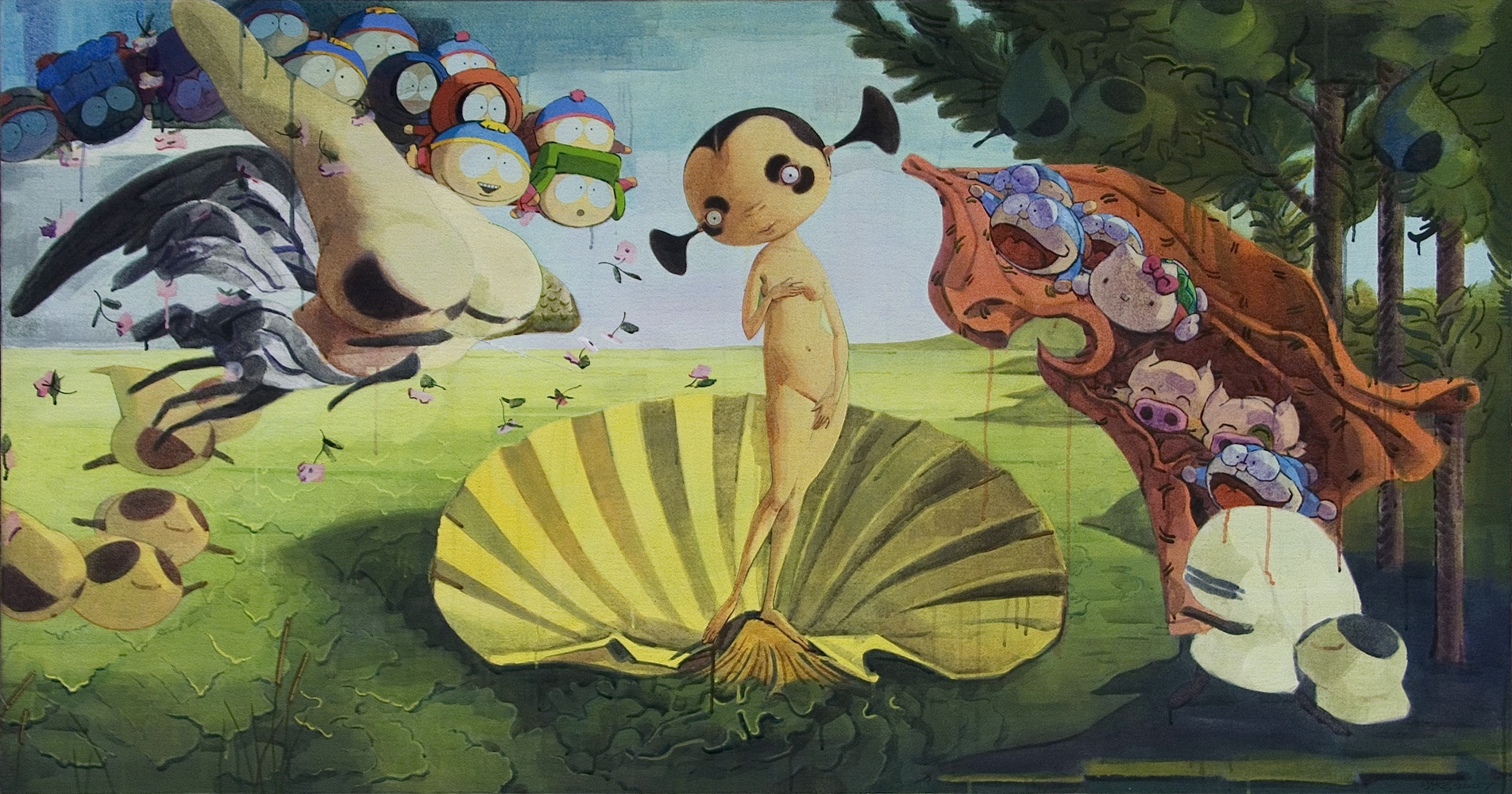
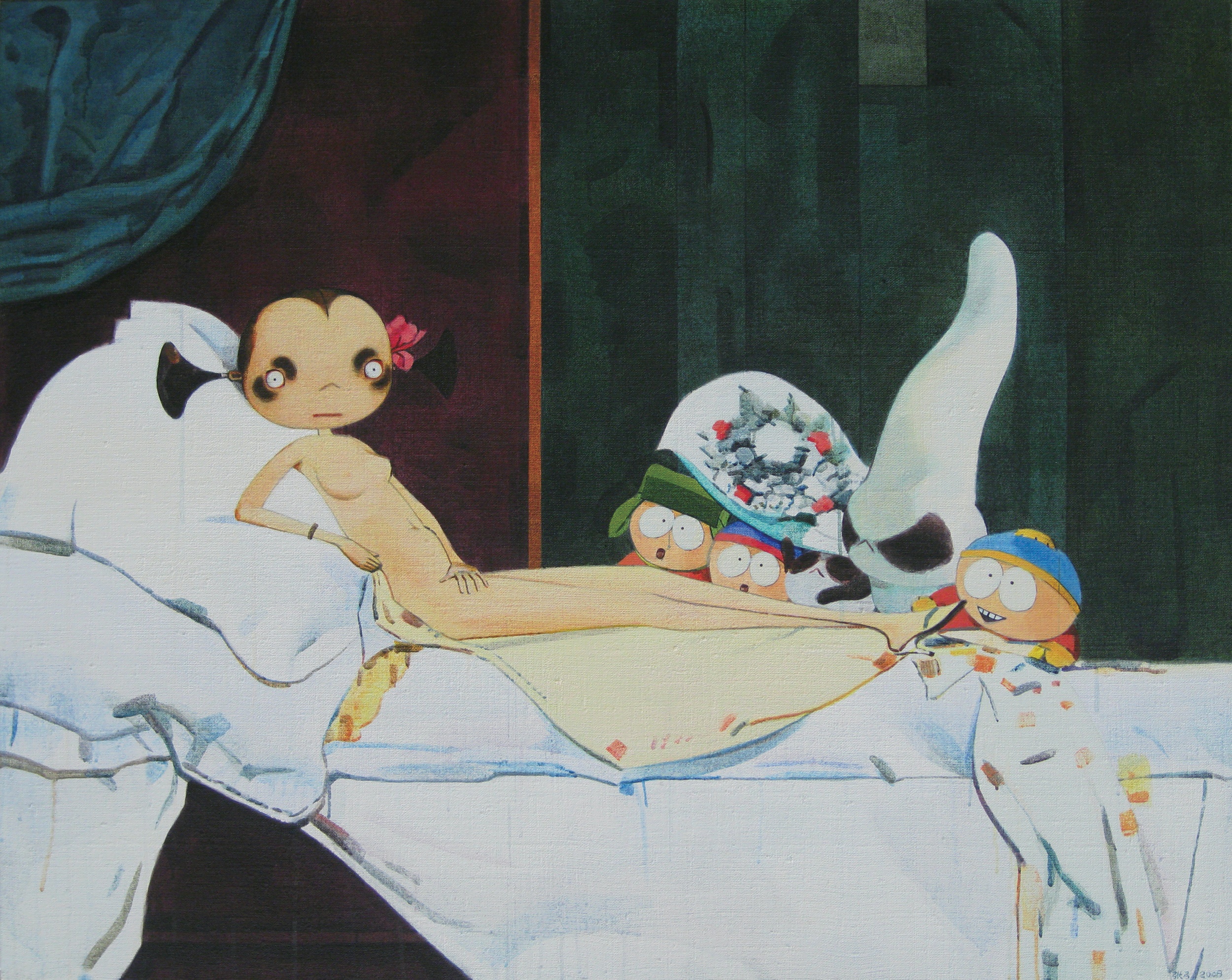
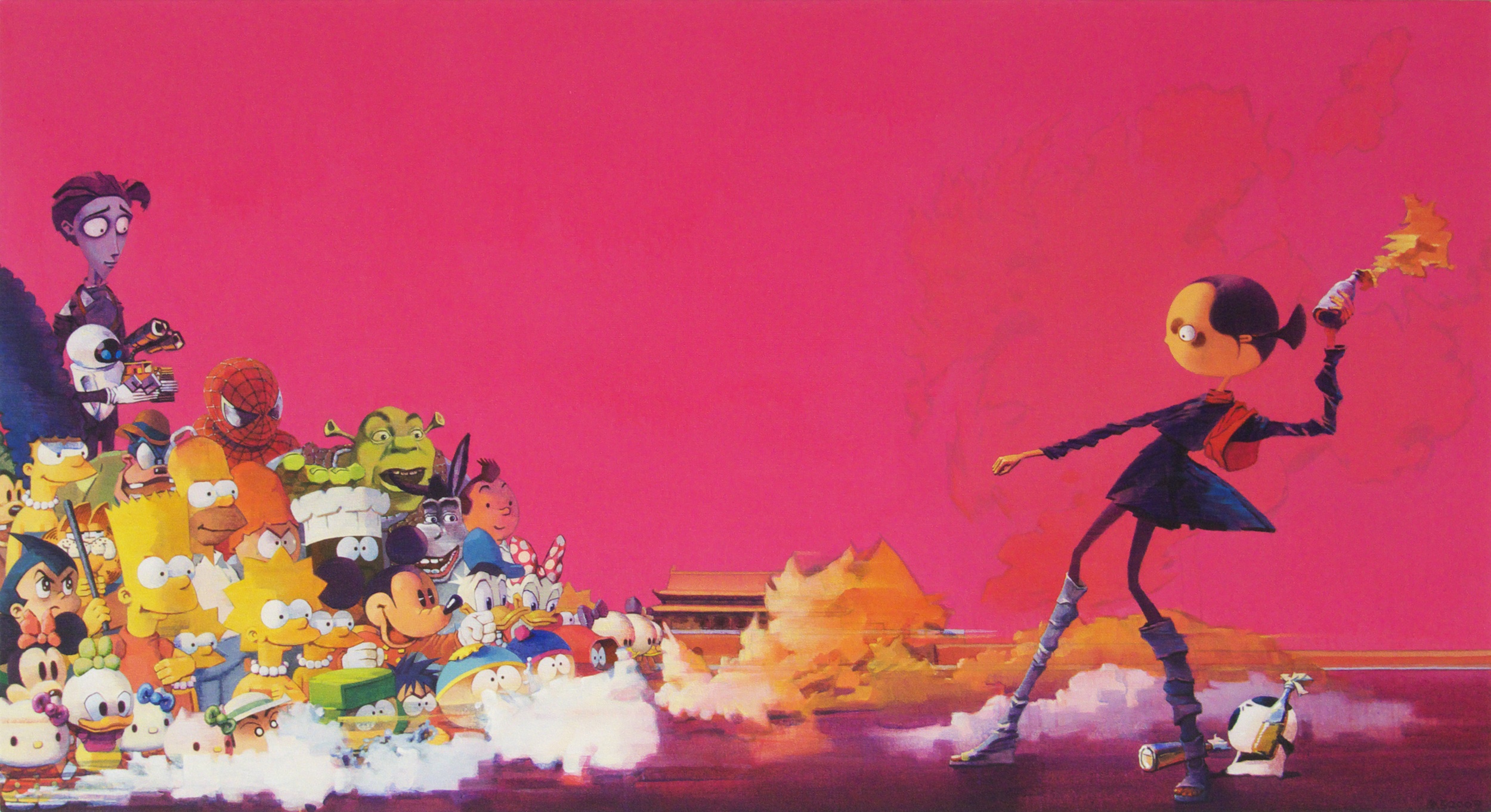
2010 - 2016: Metropolis series
After his first visit to New York in 2010, Zhang Gong officially returned to painting, focusing on New York and Beijing. Urban life in New York has become a symbol of materialistic culture, its high-density and fast pace of life inducing depression and anxiety in its inhabitants. Zhang Gong felt that the history and culture of Beijing, where he was born and raised, had deteriorated in the face of extreme commercial expansion. He recorded, painted and re-imagined the city with his brush, depicting the city's densely-layered architectural landscapes and details with extraordinary delicacy and patience, interspersing his signature characters amidst complex architectural structures. The compositions and tones of this era became more concise, capturing the textures of the city in order to represent the impact of social changes and rapid urbanisation.


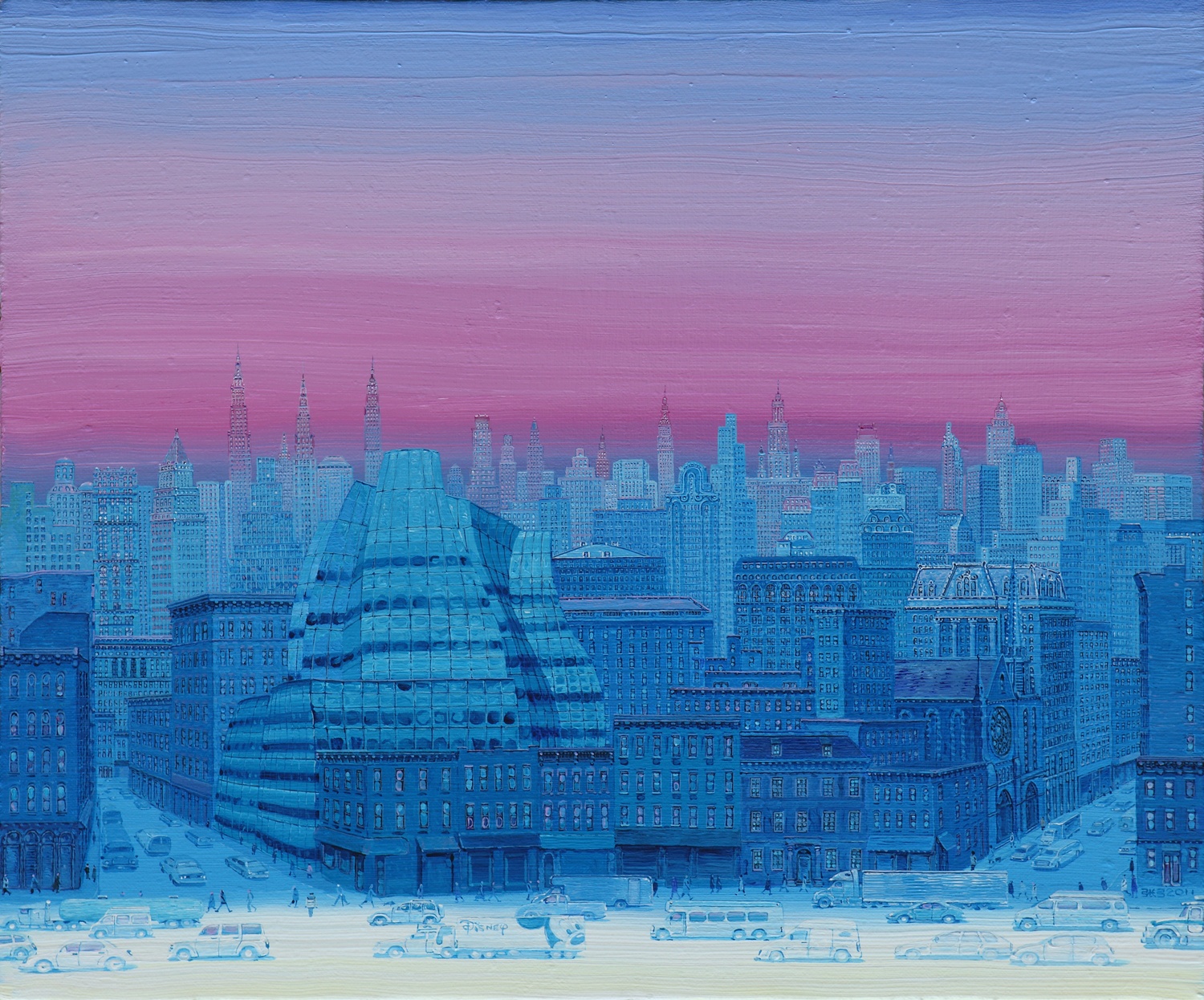
2017-present: The Garden of Eden series
Zhang Gong felt that the withdrawal of religious culture led to the decline of humanity and morality. In his recent works, he considers the relationship between faith and society, and explores the possible return of human beings to the Garden of Eden. The theme revolves around an authentic 'pure' land without regard to race, gender, nationality or culture, akin to the original state of the world. In addition to 'naïve' cartoon animals and plants, Zhang Gong's brush also adds key religious imagery and symbolism to compose pictures with a unique visual tension. Whimsical fables and narratives express complex social realities, expressing the doubts and uneasiness inherent to what we consider a good life, whilst reminding Zhang Gong's audience to reflect upon the relationships between contemporary society and so-called 'civilised' beliefs.
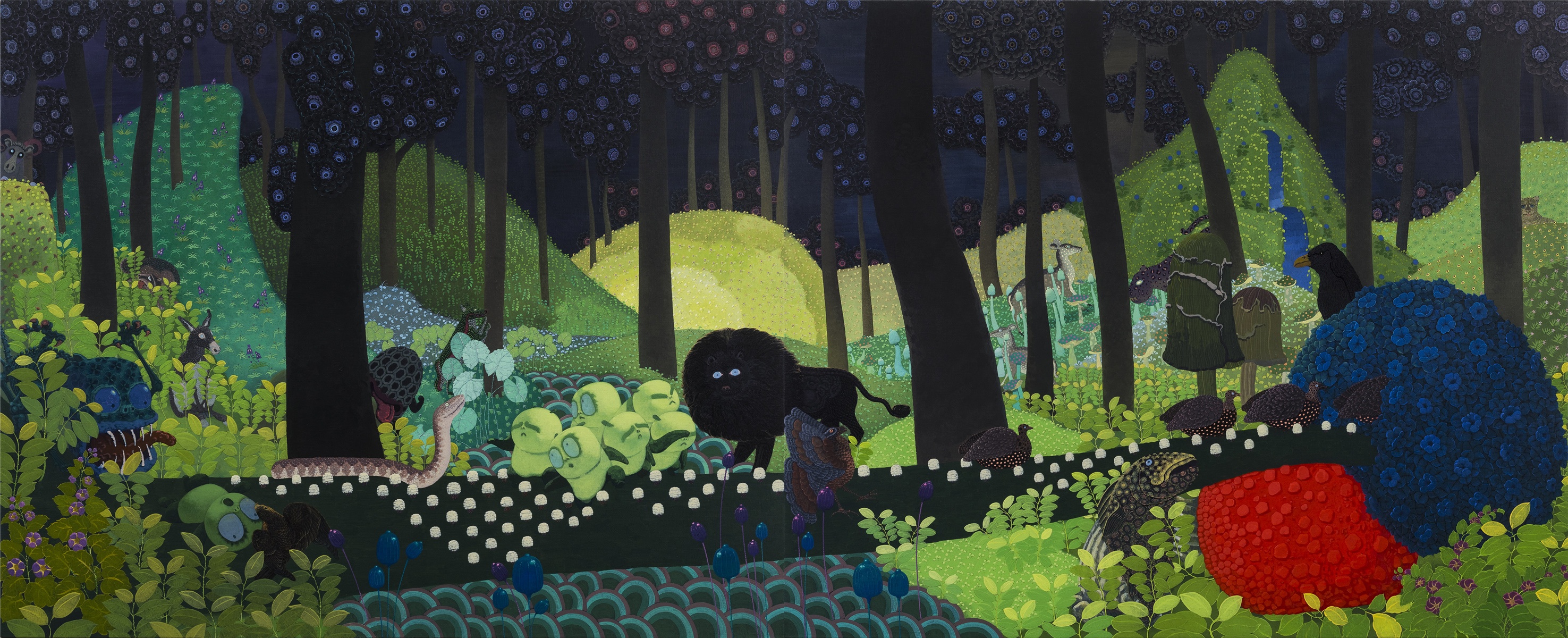 Sentimental Garden | 2018 | Acrylic on canvas | 140×344cm
Sentimental Garden | 2018 | Acrylic on canvas | 140×344cm
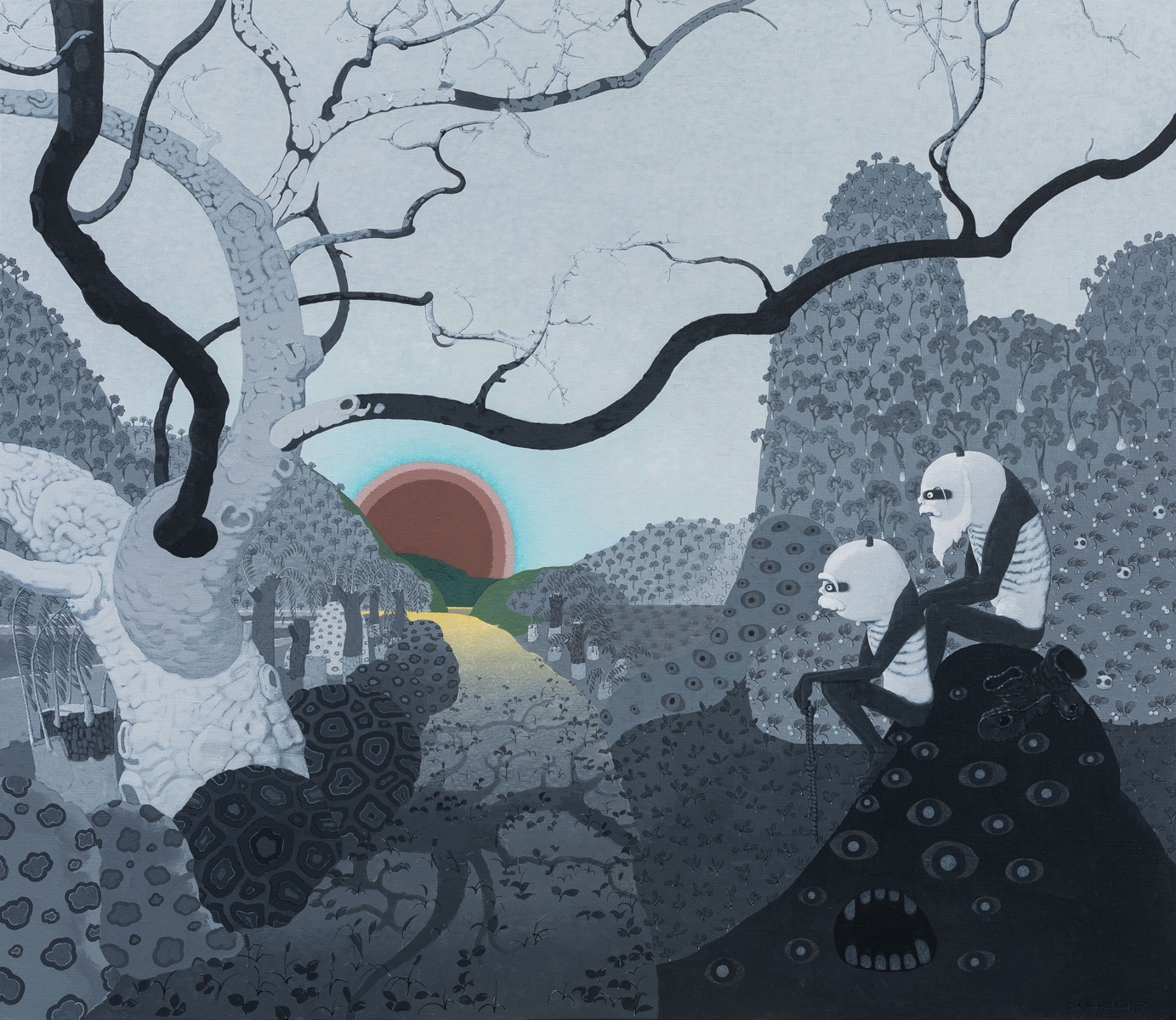
Mr. Godot Will Definitely Come Tomorrow | 2017 | Acrylic on canvas | 95×110cm
-

The Cornerstone
An Exhibition Celebrating the 30th Anniversary of Kwai Fung 14 Jun - 31 Aug 2021Read more -
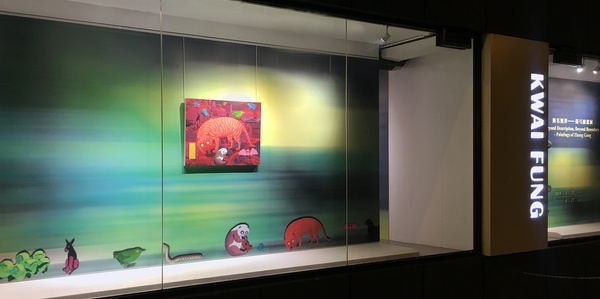
Beyond Description, Beyond Boundary - Paintings of Zhang Gong
Kwai Fung Hin Art Gallery, G/F, 20 Ice House Street, Central, Hong Kong 22 Mar - 27 Apr 2019Read more -
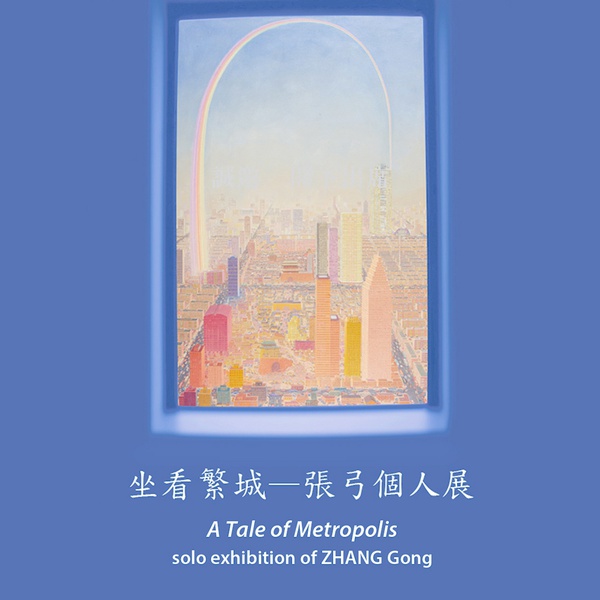
A Tale of Metropolis - Solo Exhibition of Zhang Gong
Kwai Fung Hin Art Gallery, G/F, 20 Ice House Street, Central, Hong Kong 5 - 31 Dec 2014Solo Exhibition of Zhang GongRead more



